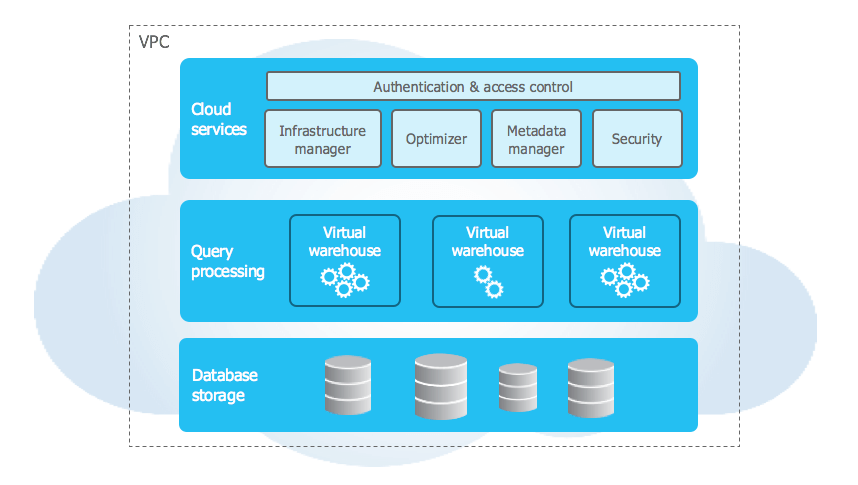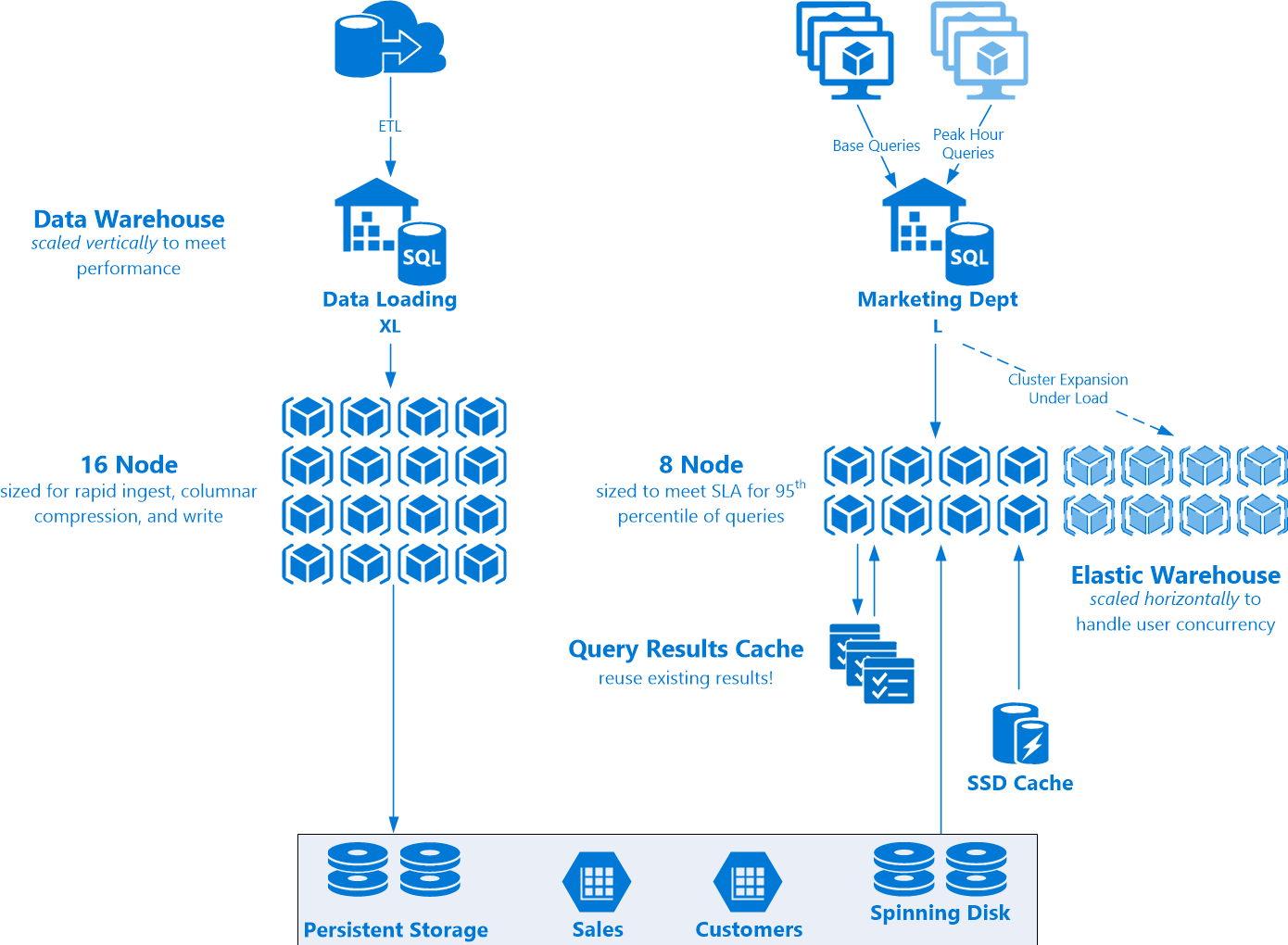Top Snowflake Interview Questions & Answers
Quickly refresh these Snowflake concepts and clear every interview that you appear for with this list of Top Snowflake Data Warehouse Interview Questions that are frequently asked:
1. What is Unique about Snowflake Cloud Data Warehouse?
Snowflake is cloud native (built for the cloud).So, It takes advantage of all the good things about the cloud and brings exciting new features like,
- Auto scaling
- Zero copy cloning
- Dedicated virtual warehouses
- Time travel
- Military grade encryption and security
- Robust data protection features
- All the data is compressed by default
- All the data is encrypted
- Its Columnar, thereby making the column level analytical operations a lot faster
2. What is Snowflake Architecture ?
Snowflake is built on a patented, multi-cluster, shared data architecture created for the cloud. Snowflake architecture is comprised of storage, compute, and services layers that are logically integrated but scale infinitely and independent from one another

3. What does the Storage Layer do in Snowflake ?
The storage layer stores all the diverse data, tables and query results in Snowflake. The Storage Layer is built on scalable cloud blob storage (uses the storage system of AWS, GCP or Azure). Maximum scalability, elasticity, and performance capacity for data warehousing and analytics are assured since the storage layer is engineered to scale completely independent of compute resources
4. What does the Compute Layer do in Snowflake ?
All data processing tasks within Snowflake are performed by virtual warehouses, which are one or more clusters of compute resources. When performing a query, virtual warehouses retrieve the minimum data required from the storage layer to fullfil the query requests
5. What does the Cloud Services Layer do in Snowflake ?
The services layer is the brain of Snowflake. The services layer for Snowflake authenticates user sessions, provides management, enforces security functions, performs query compilation and optimization, and coordinates all transactions
6. What is a Columnar database and what are its benefits ?
Columnar databases organize data at Column level instead of the conventional row level. All Column level operations will be much faster and consume less resources when compared to a row level relational database
7. What are the different ways to access the Snowflake Cloud Datawarehouse ?
You can acccess the Snowflake Data Warehouse using
- Web User Interface
- ODBC Drivers
- JDBC Drivers
- SnowSQL Command line Client
- Python Libraries
8. What are the data security features in Snowflake ?
Snowflake encrypts all customer data by default using End-to-end encryption (E2EE), using the latest security standards, at no additional cost. Snowflake provides best-in-class key management, which is entirely transparent to customers
- All the data is Automatically encrypted by Snowflake using Snowflake-managed keys.
- All communication and data transfer between clients and the server protected through TLS
- You can Choose the geographical location where your data is stored, based on your cloud region
9. How does data compression works in Snowflake ?
All the data is compressed by default in Snowflake. Snowflake chooses the best compression algorithms and its not configurable by the end users. The best thing is snowflake charges the customers based on the final size of data after the compression is applied
10. What are the benefits of Snowflake Compression ?
- Storage costs lower than native cloud storage due to compression
- No storage costs for on disk caches
- Near zero storage overhead for data cloning or data sharing
11. What is Snowflake Caching ?
Snowflake caches the results of every query you ran and when a new query is submitted, it checks previously executed queries and if a matching query exists and the results are still cached, it uses the cached result set instead of executing the query. Snowflake Cache results are global and can be used across users
12. What are the different types of caching in Snowflake ?
- Query Results Caching
- Virtual Warehouse Local Disk Caching
- Metadata Cache
13. What is the difference between Cold vs Hot Virtual Warehouse ?
The difference between Cold vs Hot Warehouse is listed here in this link
14. What is Time Travel in Snowflake ?
Time travel lets you access data as of any time in the past. For example, if you have a Employee table and if you delete the table accidentally you can use time travel and go back 5 minutes and retrieve the data back
15. How many days is the time travel history preserved in Snowflake ?
Time travel is available between 1 to 90 days based on the Snowflake edition that you signup for. Read more on Time travel duration
16. Is there a cost associated with Time Travel in Snowflake ?
Yes, Storage charges are incurred for maintaining historical data during both the Time Travel and Fail-safe periods
17. What is fail safe in Snowflake ?
Fail-safe provides a (non-configurable) 7-day period during which historical data is recoverable only by Snowflake. This period starts immediately after the Time Travel retention period ends. Fail-safe is not provided as a means for accessing historical data after the Time Travel retention period has ended
18. What is the difference between Time-Travel vs Fail-Safe in Snowflake ?
- Time travel, user can set and retrieve data going back to history, based on their snowflake edition and object or account specific time travel (day-data_retention_time_in_days) setup.
- Fail safe , user does not have control on retrieval of data applicable only after time travel period is over . In this scenario only Snowflake support can help up til 7 days only. So if you have set time travel as 6 days (Assuming) then you yourself can retrieve db objects after the transaction execution + 6 days of time. from 7th to 13th days post transaction execution snowflake support can help to retrieve your objects. After 13th days objects can not be retrieved or restored back
19. What is zero copy cloning in Snowflake ?
Cloning, also referred to as “zero-copy cloning” creates a copy of a database, schema or table, without duplication the associated storage files on disk
20. How does zero copy cloning work and what are its advantages ?
Read the advantages of Snowflake zero copy cloning
21. What is Data Shares in Snowflake ?
Snowflake Secure Data Sharing enables organizations to instantly and securely share their data. Secure Data Sharing enables account-to-account sharing of data through Snowflake database tables, secure views, and secure UDFs
22. Whats is Horizontal scaling vs Vertical scaling in Snowflake ?
- Horizontal Scaling to increase concurrency - When you have to support additional users, you can use auto scaling and increase the number of virtual warehouses to instantly support and fullfil more user queries
- Vertical Scaling to reduce processing times - When you have huge workloads and if you want to optimize it and make it run faster, you can consider choosing a bigger virtual warehouse size
